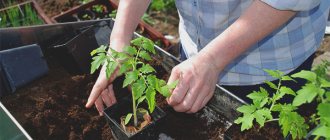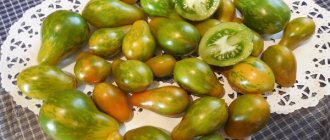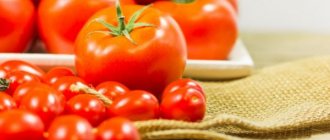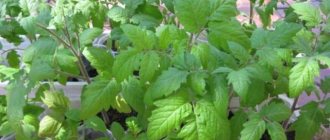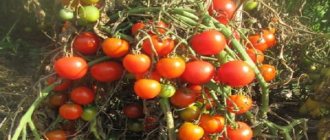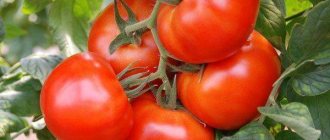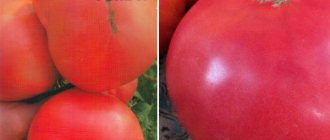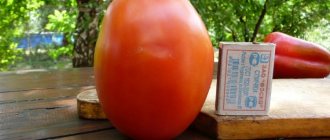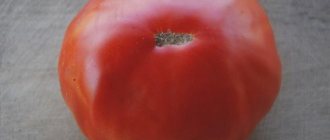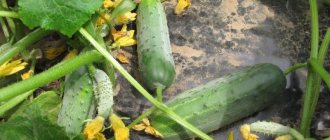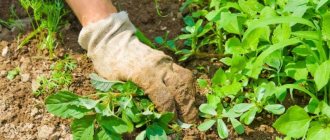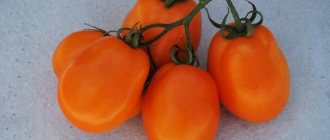Tomato Kasamori: characteristics and description of the variety, its yield with photos
The ultra-early ripening pink-fruited tomato Kasamori F1 of Japanese selection has recently been present on the Russian market, but has already become a favorite of vegetable growers who grow tomatoes in greenhouses for early production. In Japan, high demands are placed on the consumer and technological qualities of tomatoes cultivated under production conditions. The Kitano Seeds company and its hybrid Kasamori are no exception. High quality hybrid.
About the hybrid
The bush is of indeterminate type with shortened internodes, which is why it is compact. Recommended for growing in spring film and winter greenhouses. Ripens quickly, on the 90-100th day from germination. The available description of the fruits indicates that they are very large, over 200 g, bright pink in color, intended for salad purposes, and are suitable for sale on the fresh produce market. The shape of the fruit is flat-round, there are more than six seed nests. The fruits are formed in clusters of 5-6 pieces. Reviews from gardeners indicate that the fruits are never smaller than 200 g. On average, their weight is from 270 to 300 g, and the maximum is 550 g. The surface is even and smooth, a green spot does not form on the stalk, and no cracks in the fruit were noted.
Distinctive features of the hybrid
Vegetable growers with experience in growing this hybrid noted a number of its positive properties:
— good fruit set in any conditions, including stressful ones;
— high yield, an average of 4 kg of fruits are obtained from one bush;
— the possibility of growing in all types of film and glass shelters, including temporary ones, and in open ground.
Experts note the high plasticity of the Kasamori tomato; its characteristics allow it to be grown at all times of the year. The short production period is Kasamori's advantage.
Advice: plant seedlings of this hybrid at several times, as well as seeds directly into the soil for a seedless crop. The last fruits can be collected at the end of September and ripened at home. They do not lose their taste when harvested in the milky-waxy ripeness phase.
Growing seedlings
The timing of sowing seeds for seedlings depends on where the plants are planned to be planted in a permanent place. The following options are possible:
- in a spring heated greenhouse, sowing is done in mid-February;
- in a spring unheated greenhouse - at the end of February;
- in open ground - in the first ten days of March;
- direct sowing in open ground in two periods - at the end of April and at the beginning of May;
- direct sowing in open ground using an autumn mobile greenhouse - at the end of May.
Tomato seedlings need to be fed every 10-14 days. They accept humic-based fertilizers well. If there is a lack of light, the plants are illuminated with a phytolamp.
Caring for tomatoes in a greenhouse
The main maintenance work includes watering, weeding and loosening, fertilizing and shaping bushes. Tomato plants in a greenhouse need to be watered twice a week, and every other day during hot periods. After each watering, the soil must be loosened and weeds must be removed at the same time; they can be carriers of pests and diseases.
It is better if the soil in the greenhouse is mulched with peat, sawdust or any other material. Formation of a bush includes pinching of plants. Stepchildren must be removed until they exceed 2-2.5 cm, always with a disinfected instrument, for example, scissors. The plant forms into one stem. Weighty brushes need additional tying.
Tips for growing seedlings
The timing (avoidance of sowing seedlings) must be planned depending on the place where the tomatoes are planted. Here. Ant. there are several options:
- For planting seedlings in a greenhouse with a heated system, mid-February navigation is suitable.
- In a greenhouse without heating - the last days of February.
- It is recommended to plant seedlings in gaping soil in the first ten days of March.
- The benefit of planting without seedlings, but immediately in the ground, is suitable for two dates - the end of April and the beginning of May.
- Planting seeds in open ground using a mobile greenhouse in the fall - the end of May.
Kalroma – variety of tomato plant
Information on the admission of Tomato Kalroma from the Register of the State Variety Commission of the Russian Federation
Application for admission No. 31714, registered 1998-10-14. The Kalroma Tomato variety was included in the register of approved varieties in 1999. Approved for use in regions: All regions.
The originator of the Kalroma Tomato variety is:
Other varieties of tomato plant
Question to the portal experts
If you haven't found the answer to a question, don't hesitate to ask an expert.
Have you already planted Tomato Kalroma?
Tell us if you liked this variety? Will you plant it again?
Register or Login so you don't have to enter your Name and Email every time
Thanks for the comment! It will be published after checking by a moderator!
No comments yet, be the first!
A portal for those who love their dacha
Your question has been sent for moderation. Don't worry, we quickly check your questions and your question will be answered within 1 day.
We have noticed that you are already registered on our website. We recommend that you log in to view the created question.
If you don't remember your password, you can recover it.
You were not registered until today, so we have registered you. Your password has been sent to your specified mailbox.
Help our site develop!
Please read this message, it will not take up much of your time!
We so need your comments and questions to understand in which direction we should develop.
Don't forget to leave a comment if you found what you were looking for. And if you haven’t found it, use the “Ask an Expert” form in the site header. We will answer this question, and other visitors will be able to find the information that you could not find.
Your question has been sent for moderation. Don't worry, we quickly check your questions and your question will be answered within 1 day.
We have noticed that you are already registered on our website. We recommend that you log in to view the created question.
If you don't remember your password, you can recover it.
You were not registered until today, so we have registered you. Your password has been sent to your specified mailbox.
For growing on the balcony
The easiest guide when buying seeds is the inscription on the package “balcony variety”
Also pay attention to the following characteristics:
- self-pollinating;
- early ripeness;
- compactness;
- immunity to disease;
- shallow root system.
You cannot place containers with different varieties of tomatoes nearby. If cross-pollination occurs, the quality of the crop will be affected.
The most popular in our country are:
- Balcony miracle - a small compact bush literally strewn with small tomatoes, average weight 60 g. Self-pollinating, early ripening variety. It is grown all year round, the yield is up to 2 kg per bush.
- Ballerina F1 is an early-ripening hybrid; up to 2 kg of tomatoes are harvested from a bush. It stores well, has strong immunity to disease, tolerates temperature changes well, and is very tasty.
- Yellow Pearl is an early ripening variety with small yellow fruits weighing about 30 g. Undemanding to lighting. The compact bush produces up to 6 kg of harvest.
Tomato Yellow Pearl
Tomato Amber Cup - description and characteristics of the variety
This variety with the sonorous name “Amber Cup” caused a real storm of rejoicing among summer residents and gardeners. Thanks to many years of efforts of breeders, it embodies high yields, excellent taste of fruits and high commercial characteristics. A plus to everything is its resistance to diseases and adverse weather conditions.
Characteristics and features of the variety
Tall (indeterminate) type of tomato. Registered in the State Register of Varieties of Russia. The habit of the bush is powerful, with an average height of 1.5–1.8 m, well leafy.
The fruits of this variety are very dense, with thick walls, resistant to mechanical deformation. They are smooth, without pronounced ribbing. When fully ripe, it has a beautiful, rich orange-yellow, or rather amber-golden color. Medium-sized tomatoes, 100-130 g, rectangular-round shape. Simply put, the shape of the fruit is “cream”. Tomatoes are collected in open clusters of 6-8 fruits.
Despite the significant density of the fruit, the pulp of the variety is tender, aromatic, and moderately juicy. The tomatoes are tasty and sweet. The skin is thin, but strong, elastic, and resistant to cracking.
Suitable for cultivation in both protected (film, polycarbonate, glass greenhouses and tunnels) and open ground conditions.
Strengths of the variety
- Resistance to negative external factors.
- The variety has good vigor, open clusters, and the fruits are easy to pick.
- Suitable for growing in open and protected ground conditions.
- High yields: in protected soil conditions - up to 10 kg per 1 sq. m. And when grown in open ground - up to 4-5 kg.
- Successful tolerance of minor frosts and temperature changes.
- Ability to set fruit well in very hot weather.
- Resistance to major diseases and pests of nightshade crops. In particular to fusarium and verticillium.
- Consistently high commercial characteristics of the fruit. Original color of tomatoes.
- High shelf life and transportability of fruits.
- Capable of long-term (up to 2) months storage.
- The bushes are resistant to rotting if the correct temperature and humidity conditions are observed.
Secrets of successful cultivation of the variety
- Planting - no more than 3-4 plants per 1 sq.m. It is necessary to avoid thickening of plantings and ensure their good ventilation. Especially in protected ground conditions.
- Compliance with the planting scheme: 40-50 cm between plants in a row, row spacing - 1 m.
- Formation of a bush of 2-3 strong shoots.
- Planting in well-lit areas.
- Carrying out several preventive treatments using plant protection products (plant protection products).
- Removing the lower leaves on the stems, removing the stepsons every 10 days.
- Planting seedlings in the ground at the age of 60-65 days.
- Tie to a trellis or support a few days after planting the seedlings in the soil.
- Carrying out regular sanitary cleaning and maintaining a high agricultural background.
- Adding rotted manure to the soil. Regular fertilizing with complex mineral fertilizers. Treatment frequency is 10-14 days.
- Alternating spraying with a fertilizer solution on the leaf with watering at the root.
- Sowing seeds for seedlings in late February/early March.
- Water the seedlings with warm water, avoiding moisture on the foliage.
- Using a high-quality, nutritious substrate for growing seedlings that does not contain insect larvae and spores of harmful fungi.
Oksana Vladimirovna, 35 years old:
How can you not buy a tomato with such a beautiful name? Don't know. So I bought it, planted it, and got a harvest! Cool, really amber, medium-sized tomatoes. And the harvest is generous. And they’re delicious, mmm... You can make whatever you want out of them. We roll it up, eat it, cut it into small cubes and freeze it for the winter. My son even manages to cook delicious food on the grill! A universal tomato for all occasions. I recommend!
Svetlana Gromova, 51 years old:
It’s always nice when tomatoes, in addition to being useful for home consumption, also help you make money! On weekends I trade at the market, during the season there is a significant increase in my pension. The buyer is attracted, first of all, by the beautiful appearance. Especially the orange-amber color of tomatoes. It is easy to grow. He rarely gets sick, is indifferent to the weather, and in general is a hard worker. And of course we are looking forward to the wonderful fruits of the Amber Cup. Now he is a permanent resident in my beds.
Description of the tomato variety Tmae 683 f1 new from Japan
Early tomatoes are often grown by many gardeners. Tomato "Tmae 683" f1 is a hybrid, therefore stronger and more unpretentious. Country of origin: Japan.
What is the variety
To get a complete picture of the type of tomato that will be grown on the site, you need to study its characteristics.
Plant:
- Bush: determinate.
- Stem: powerful.
- Height: 60–110 cm.
- Ripening time: 90–95 days
Fruit:
- Shape: flat-round.
- Color: red.
- Weight: 175–210 g.
- Number of cameras: 4–6 pcs.
- Density: high.
- Transportability: good.
- Shelf life: 1.5–2 months.
- Presentation: excellent.
Planting and care
Tomato seeds for seedlings are sown two months before planting in the ground. After the appearance of 1 true leaf, the seedlings dive. This is necessary so that the tomatoes can more easily take root in their permanent location.
It is recommended to harden tomatoes 10 days before transplanting. Take them outside and leave them for 20 minutes first, then gradually increase to 8 hours.
The plant needs to be tied to supports.
Planted in open ground at the end of May. The distance between plants is 40–50 cm, between rows 60 cm. Thus, 4 to 6 plants are placed per 1 m2.
Further agrotechnical techniques are the same as for growing other varieties. Be sure to feed with complex fertilizers at least 2 times per season.
Disease susceptibility
Tomatoes "Tmae 683" f1 are a hybrid variety. Therefore, it is immune to certain diseases. Such as:
- Late blight.
- Fusarium.
- Verticillium wilt.
- TMV, tobacco mosaic virus.
Harvest volume and application
If all the requirements and rules for planting tomatoes are met, one bush can grow 1–1.5 kg of vegetables. And 1 m2 gives from 3 to 5 kg of yield.
The new product has not yet received wide distribution. But those who grew this tomato variety talk about its versatility. It goes well in early summer salads. It is also widely used in home canning. Suitable for processing into tomato paste, juices and much more.
Positive and negative aspects of the variety
Any tomatoes have pros and cons. Their number determines whether the species will be successful or lost among its own kind.
Pros:
- Unpretentiousness.
- Versatility.
- Immunity to certain diseases.
- The fruits do not crack, are well stored, and retain excellent presentation when transported over long distances.
- Early maturation.
Minuses:
Seeds collected independently do not retain the parental genes.
Opinions of summer residents regarding tomatoes "Tmae 683"
Often, a lot of information about tomatoes can be obtained by reading reviews from summer residents. Many share their impressions, ideas, or simply give valuable advice on growing.
Hybrid varieties are liked by many summer residents because they are more resistant to diseases and less demanding on weather conditions. As a result, there is always a harvest.
The best varieties of tomatoes for open ground
When planting tomatoes in open ground, you need to take into account the specifics of the soil, the occurrence of groundwater and possible seasonal frosts.
Boni MM
A very early and compact variety with neat, identical fruits up to 85 g. This is an ideal choice for canning, including on an industrial scale.
Petrusha the gardener
The salad pink variety, originally from Altai, is suitable for early sowing. Multi-chambered, fleshy fruits with a sweetish taste weigh about 165 g.
Geranium Kiss
This beautiful American variety is valued not only for its taste, but also for its decorative qualities. The bushes are very compact, densely covered with foliage and small oval tomatoes of bright red color up to 40 g.
Persimmon
A beautiful yellow variety with a long history, it is valued for its high yield and sweet fruits weighing about 225 g. Even if you had to pick the tomatoes ahead of schedule, they ripen well.
Kaspar 2
The modified hybrid produces a generous harvest of elongated cylindrical fruits of approximately 85 g. The variety is grown in all regions of Russia for salads, canning and processing.
Kasamori F1 tomato seeds indet. early 105-115 days. okr.-prip. 300-550g roses. (Kitano Seeds)
Order by phone
- +38 ( 050 ) 699-12-64
- +38 ( 066 ) 827-50-68
- +38 ( 066 ) 827-50-68
- +38 ( 067 ) 771-68-61
- +38 ( 068 ) 347-43-44
- +38 ( 097 ) 058-95-54
- +38 ( 093 ) 348-47-82
- +38 ( 063 ) 238-93-97
Important
No minimum order amount! But prepayments are required:
- for orders up to 200 UAH;
- for goods to order - 100% prepayment;
- Each order contains a gift.
Delivery methods
Every day:
- Nova Poshta
- Ukrposhta
- Autolux
For order values over 2,500 UAH and weight up to 500 grams, delivery is free (from 12/15/2018)
Discounts
When ordering for 3,000 UAH - 3% discount, 5,000 UAH - 5% discount, 10,000 - 10% discount
Discounts cannot be combined!
Receive gifts by ordering online
Each customer who places an order online (by registering in the store and making purchases through the basket) receives a magazine, a package of seeds and a calendar as a gift (included in the order from September to January).
Contacts for placing an order in the ATO zone
We accept orders for vegetable seeds from the ATO zone
Telephone: 066 061 04 03
Tomato Kasamori F1 description:
Kasamori F1
indeterminate pink tomato seeds (Kitano Seeds). Ripening period is 95 – 105 days. High-quality, stable, productive hybrid for the first rotation in film greenhouses. Indeterminate ultra-early tomato. The plant is powerful, compact, with a short distance between nodes, capable of forming 5-6 marketable fruits per cluster. The tomatoes are very dense, flat-round, deep pink, with an average weight of 300-320 grams (can reach 500-550). Advantages of Kasamori F1: lack of greenness at the stalk; resistance to heat changes; high taste and sugar taste; abundant fruiting even under stressful conditions.
Kasamori F1 tomato seeds (Kitano Seeds) can be in two types of packaging:
– original packaging (from the manufacturer)
– Seed Supermarket packaging.
If you only need seeds in original packaging, please indicate this in the comments to your order or tell the sales consultant this when placing your order by phone.
The manufacturer reserves the right to change the packaging design, color and availability of seed treatment.
If this item does not have a package with a suitable number of seeds, please inform our sales manager - he will try to help you open the package or offer a suitable analogue.
Tomato varieties for greenhouses: photos, videos, descriptions
The opening of the summer season is just around the corner. Avid gardeners scour the Internet in search of useful information and try to “discover” new varieties.
And first of all, this concerns tomatoes - the most popular crop among gardeners. To obtain a high-quality tomato harvest, it is important to choose the right variety
Especially for lovers of tasty, fleshy, sugary and aromatic tomatoes, we have selected the best varieties of tomatoes for greenhouses. Some of them have been popular for many years, while others are new, but have proven themselves well among summer residents.
As a rule, indeterminate or, in other words, tall varieties of tomatoes are grown in greenhouses. They are powerful vine-like, continuously growing bushes on which a large number of tomato clusters are formed throughout the growing season. All tall varieties of tomatoes require garter.
Among greenhouse tomatoes, the seeds of hybrids and pure varieties have proven themselves to be the best:
- Kasamori;
- Pink Paradise;
- Tolstoy;
- Sir Elian;
- Honey saved;
- King of the Giants;
- Cio Cio San.
All of them are high-yielding, resistant to viral diseases and stressful situations. They tolerate temperature changes without problems.
The best varieties of tomatoes for greenhouses
Tomatoes are a must-have vegetable for planting in any summer cottage, since tomatoes in our region are a favorite vegetable for many. Any gardener wants to grow a good harvest on his plot, despite unfavorable weather, pests and minimal care. What variety of tomatoes can even the laziest summer resident successfully grow?
Kasamori F1 is an ultra-early ripening pink-fruited tomato from Japanese breeders. Ripens after 90 days from germination. Flat-round tomatoes weighing from 200 g are formed in bunches of 5-6 pieces. The surface of the tomato is smooth, glossy, the taste is sugary, sweet. Suitable for preparing fresh salads, it is also incredibly tasty in canned form.
Tomato variety Pink Paradise F1 Tomato variety Kasamori F1
Pink Paradise F1 is another pink-fruited Japanese tomato with excellent reviews. The fruits have a flat-round shape, weight from 250 g. They ripen after 100 days from germination. Juicy, fleshy and sweet tomatoes are ideal for fresh consumption, sauces and purees. A dense, but not hard skin protects the tomato from cracking.
A peculiarity of tomatoes of this variety is that, unlike other tomatoes, the fruits of Paradise F1 do not have a green mark near the stalk.
Tolstoy F1 is an early-ripening cocktail tomato created by Dutch breeders. The fruits are dark red, smooth, like balls, very tasty, weighing from 80 to 120 g. They ripen in clusters of 7 pieces.
They delight us with a friendly and high harvest. Tomatoes have a thick skin, so they are ideal for canning and pickling.
The Tolstoy F1 variety is a hybrid, so collecting seeds for planting on your own is not practical. They can be purchased annually at a specialty store.
Tomato variety Tolstoy F1 Tomato variety Sir Elian F1 Sir Elian F1 is an early red-fruited plum tomato from French breeders. The fruits are elongated, each weighing 130-150 g. Each cluster contains 7-9 fruits. A very productive variety. The first fruits are harvested 55-60 days after planting the seedlings. Tomatoes have a distinct tomato flavor and are suitable for salads, canning whole or in slices. Ideal for drying.
Honey Spas is a large heart-shaped tomato with a rich yellow-honey color from a Siberian agricultural company. The tomato is mid-season, the fruits are of different sizes - from 200 to 600 g. Sweet tomatoes with a barely noticeable sourness will become a real decoration for the table.
Variety Honey saved Variety King of Giants
The King of Giants is a large-fruited red tomato from Siberian breeders, with a medium ripening period. The fruits are flat-round in shape, the weight is truly royal - from 500 g. The tomatoes are sweet and shelf-stable. Suitable for fresh and winter salads, as well as for making juice.
Chio Chio San
The fruits are even, one to one, the skin is tender but quite dense, the taste is classic tomato.
Varieties of greenhouse tomatoes for fresh consumption and processing
| Kasamori F1 | Tolstoy F1 |
| Pink Paradise F1 | Sir Elian F1 |
| Honey saved | Chio Chio San |
| King of the Giants |
You can always try to grow a tomato, and only then, based on the results of the season, draw conclusions.
Tomatoes, like all other greenhouse crops, require careful attention. Water, fertilize, pick off the shoots on time and you will be provided with a harvest until the frost!
The best varieties of tomatoes for a greenhouse - photos, descriptions and characteristics
Very soon the active summer season will begin and gardeners will get down to important things in the garden beds and greenhouses. And now, when you are ready to work, it’s time to decide what exactly you want to grow this year - today’s post will be useful for those who love tomatoes and are engaged in or are just planning to start growing them not in open ground, but in greenhouses. Tomatoes are one of the most popular vegetables around the world, let's discuss those varieties that bear fruit better than others in greenhouse conditions.
Tomato varieties for greenhouses most often have powerful tall bushes, fleshy fruits with a good content of sweetness. Below we will bring to your attention a selection of the best varieties - this list will include new products that are actively gaining popularity and varieties that have long been familiar to us.
The most obvious sign of a “greenhouse” tomato variety is its indeterminateness (tall plants) and liana-likeness (constant growth), due to this, on the branches we have a larger number of ovaries and fruits, which continue to develop throughout the entire growing season. Of course, such plants need a good garter to avoid breaks and death of the bush.
Growing greenhouse tomato seedlings is not very different from a similar process with varieties for open ground, but this needs to be done much earlier, since no external factors or weather conditions will have a special impact on young tomato bushes.
The best varieties of tomatoes for the greenhouse
Both “pure” and hybrid varieties of tomatoes are suitable for growing in a greenhouse; high-yielding varieties that are resistant to diseases and calmly respond to temperature changes have become especially popular - the King of Giants and Kasamori, tomatoes Honey Spas, Pink Paradise, Sir Elian and Tolstoy, as well as variety Cio-Cio San. We’ll talk about them today, find out their main characteristics and description.
- Kasamori
- King of the Giants
- Honey saved
- Pink Paradise
- Sir Elian F1
- Tolstoy
- Cio-Cio San
Distinctive features of the hybrid
Vegetable growers with experience in growing this hybrid noted a number of its positive properties:
– good fruit set in any conditions, including stressful ones;
– high yield, an average of 4 kg of fruits are obtained from one bush;
– the possibility of growing in all types of film and glass shelters, including temporary ones, and in open ground.
Experts note the high plasticity of the Kasamori tomato; its characteristics allow it to be grown at all times of the year. The short production period is Kasamori's advantage.
Advice: plant seedlings of this hybrid at several times, as well as seeds directly into the soil for a seedless crop. The last fruits can be collected at the end of September and ripened at home. They do not lose their taste when harvested in the milky-waxy ripeness phase.
Description of the Creme Brulee tomato variety, growing features and careRead
Features of agricultural technology
Kasamori tomatoes are grown not only in film structures, but also in other types of greenhouses. In regions with a warm climate, plantings are possible directly in open ground, as well as under temporary shelters. And since this hybrid ripens early, it is perfect for year-round cultivation in heated greenhouses.
The formation of a tomato bush is carried out in 1 stem. All growing lateral stepsons must be removed.
Tomato Kasamori F1 - description and characteristics of the variety
Recently, in the markets of our country you can see the miracle of Japanese breeders - the super early ripening Kasamori tomato. Despite its novelty, vegetable growers have already chosen this species for its early ripening in greenhouse conditions.
Japanese producers place very strict demands on their products, including tomatoes under production conditions. This hybrid, called Kasamori, was developed by the Kitano Seeds company, all of their products are high-end. The hybrid developed by the company satisfies all the needs of even the most demanding gardeners.
What is a Kasamori hybrid?
The fruit has a round, flattened shape. Has about six nests with seeds. Approximately 5-6 fruits ripen on each cluster of the plant. On average, the weight of each tomato ranges from 270 to 300 grams, the largest weight was recorded at 550 grams.
The structure of the tomatoes is even and smooth, no green spot is formed near the base and no cracks were noticed in the fruit.
Experienced gardeners and vegetable growers talk about the positive aspects of the hybrid:
- The fruit ovary is formed regardless of external conditions.
- The fertility of the variety is average - up to 4 kg of harvest can be obtained from each bush.
- The versatility of growing in a variety of conditions: greenhouse (glass and film), in open ground.
A special feature of the Kasamori tomato is its ability to grow and bear fruit at any time of the year under the created greenhouse conditions. The production period does not last long, which sets this species apart from other tomatoes.
Experienced gardeners give advice: plant Kasamori seedlings at different times. Alternatively, plant the seeds in open ground. If you follow these recommendations, you can enjoy tomatoes on the table until mid-autumn. At the end of September, you can harvest the last harvest and leave it at home to ripen. The taste of the tomato is preserved throughout the entire period.
Tips for growing seedlings
The timing for sowing seedlings needs to be planned depending on the place where the tomatoes are planted. There are several options here:
- The period for planting seedlings in a greenhouse with a heated system is mid-February.
- In a greenhouse without heating - the last days of February.
- It is recommended to plant seedlings in open ground in the first ten days of March.
- For planting without seedlings, but directly into the ground, two dates are suitable - the end of April and the beginning of May.
- Planting seeds in open ground using a mobile greenhouse for the fall - end of May.
Seedling care
After planting seedlings, they need to be fed every 10-14 days. Humic-based fertilizer is ideal for fertilizing. For good growth of tomatoes, sufficient lighting is required; if there is not enough light, you need to use an ultraviolet lamp.
How to care for tomatoes in greenhouse conditions
In a greenhouse, tomatoes actively need watering. You need to moisten the soil twice a week, and in hot weather - once every two days. It is necessary to ensure that the soil for Kasamori tomatoes is loosened and weeded in time. Weeding is an important point in plant care, since weeds can harbor pests and diseases.
It is better to mulch greenhouse soil with sawdust or peat. Form bushes by removing excess leaves from the stem. Removal of stepsons should be carried out while their size is no more than 2.5 cm. Disinfected tools must be used to shape them. To support heavy brushes, use a tie.
Specifics of cultivation
Seeds can be sown in February in a spring greenhouse. If it is heated, then it is possible to start sowing in the middle of the month, and if it is unheated, then at the end. In the first half of March, seedlings can be sown directly into open ground. If you want to plant seeds directly in open ground, it is better to do this at the end of April or beginning of May, when the soil has warmed up.
Fertilizer feeding is done every 2 weeks. Tomatoes love humic-based fertilizers. For better growth, the plant needs enough light, so if there is not enough light, you should use a phytolamp.
Care
Farmers will have to pay close attention to soil moisture. Tomatoes should not be oversaturated, especially when it comes to watering during fruit formation. Excessive watering at this stage will lead to cracking. Tomatoes of the Kuostrale variety can be planted deep, removing the lower leaves. This will avoid problems with bushes withering in dry and hot weather.
In the first few weeks, you need to carefully loosen so as not to harm the root system. Later, loosening is carried out more often. This stimulates proper air exchange and has a positive effect on the resistance of tomatoes to adverse external factors.
Kuostrale tomatoes are fed thoroughly during transplantation and flowering. During the flowering period, preference should be given to potassium fertilizers, which help the bushes set fruit on time. Proper fertilizing guarantees smooth ripening of the crop.
If there are signs of slow growth or leaf deformation or yellowing appears, additional fertilizer materials are added, which are dominated by calcium and magnesium.
Characteristics of the Kasamori tomato with reviews from gardeners
When choosing a foreign variety for planting, it is advisable to read more carefully than usual its characteristics and reviews of other gardeners. It may not be suitable for certain conditions. But the Kasamori tomato from Japanese breeders has become quite fond of our vegetable growers, having taken root in the Russian market.
Description of the variety
The Kasamori F1 tomato entered our market relatively recently, but thanks to its characteristics it has already become popular. Is a hybrid. Registered in 2010. The seeds are produced by the Japanese company Kitano Seeds.
Tomato is classified as indeterminate. Tomato bushes grow up to 1.5-2 m. The plant is powerful, but compact. Internodes are shortened. The hybrid is very early in ripening time. Harvesting is carried out already on the 95-105th day from the moment of emergence.
This tomato is large-fruited. The average weight of tomatoes is 300 g. But they practically never come in less than 200 g. In some cases they grow up to 500 g. The tomatoes are very beautiful, this can be clearly seen in the photo. The fruits are dense, with a smooth and even surface, with a sugary taste. The color is rich pink with a raspberry tint.
The main characteristics of a tomato can be seen in the table:
According to ripening time
By type of growth
By type of use
By growing method
Fruit weight (g)
Productivity (kg/m2)
Ripe fruit color
Fetal characteristics
Early ripe Indeterminant Salad type For film greenhouses 270-300 10-12 Pink Flat-round, even, dense, up to 6 pieces per cluster.
Advantages and disadvantages
The Kasamori tomato is distinguished by its high set rate even in stressful situations for the plant, and early and uniform ripening of the crop. Other positive aspects include:
- high yield - up to 4 kg or more per bush;
- fruits of excellent presentation;
- excellent keeping quality of the harvested crop;
- excellent taste.
The disadvantages of this tomato include the need for increased attention to it - this is the mandatory removal of stepsons throughout the season and regular feeding of the plant. You can learn how and what to feed tomatoes from a special article on this topic. It is also worth noting some difficulties in purchasing seeds and their high cost.
Features of agricultural technology
Kasamori tomatoes are grown not only in film structures, but also in other types of greenhouses. In regions with a warm climate, plantings are possible directly in open ground, as well as under temporary shelters. And since this hybrid ripens early, it is perfect for year-round cultivation in heated greenhouses.
The formation of a tomato bush is carried out in 1 stem. All growing lateral stepsons must be removed.
New collection of tomatoes - all inclusive!
MAGAZINE “THE REAL OWNER” No. 11, 2012
I am engaged in growing tomatoes in the town of Kamenka-Dneprovskaya, Zaporozhye region. I grow them in my greenhouses in order to learn for myself the characteristics of a particular hybrid and give recommendations based on personal experience. Our region specializes in growing tomatoes in greenhouses. I would like to make a short overview of the tomato group in our region. This year the price of tomato was quite high. In July, the wholesale price for pink tomatoes remained at 8-9 UAH. per kg. And there wasn't that much tomato. It was profitable to grow it. Moreover, pink tomatoes, large-fruited and medium-sized, were in good demand. I'll tell you about the most successful hybrids. In the pink tomato category, several hybrids deserve special attention. Tomato Kasamori F1 is early, reaches a weight of 240-270 g, very good results when grown in the first rotation. It's really early. At the end of spring (when planting in February) and early summer (when planting at the end of March), we already sell our harvest of this tomato. At this time, tasteless imported tomatoes are sold in the markets. And our delicious commercial pink tomato is selling with a bang. In the fall, there are a lot of cream tomatoes on the market, which are oaky and tasteless. And at this time, our delicious beautiful tomato is again in high demand. It is of great importance that this hybrid does not crack at high humidity. The next strongest pink tomato leader of this season is KS 222 F1. Its advantages: tasty, bright pink, marketable, dense, does not crack, does not hurt. The quality of the fruit is super! Weight is 300-400 g. The small foliage of the plant is advantageous for growing in film greenhouses. It tolerates not only cold, but also extreme heat. You feel the quality of the fruit when you take the tomato in your hand. It is dense, heavy, beautiful, fragrant! The hybrid KS 14 F1 closes the top three leaders in pink-fruited tomatoes. Uniform fruits down to the very last cluster, high evenness, consistent ripening cluster by cluster are the key features of this hybrid. This is a generative type tomato, with little foliage, which makes it easier to care for in a greenhouse. The fruits are highly rounded, weighing 200-250 g. Relatives from the Krasnodar Territory told me that this tomato is successfully grown and sold in Russia by the Chinese, who settled there and built film greenhouses in teams. In the orange tomato category, we were pleased with the hybrid KS 10 F1. The fruit is large, weighing 250-350 g, amber, dense, fleshy, sugary in taste, anti-allergenic. This year, farmers handed it over to supermarkets. This is a small but interesting tomato niche that is beginning to rapidly gain momentum. This tomato hybrid transports well. If you remember, about five years ago everyone grew red tomatoes, because there was no high-quality pink hybrid on the market for industrial cultivation. And when Japanese pink tomatoes appeared, many farmers switched to growing them. The pink tomato gives great profit even in the summer, when the ground toma bears fruit. Now the situation is the same with the orange tomato, which outperforms the red tomato in price and is gaining popularity among consumers. Since I have been familiar with the described tomato range for several years now, I can say with confidence that these tomatoes have shown themselves to be excellent. Starting from the traditional red tomato of any size, from lettuce to cherry, including the amazing pink tomato, to the orange and yellow exotic tomato. As they say, everything is included.
Japanese breeders rely specifically on the taste of the tomato. And I was convinced of this myself. Along with excellent presentation, the listed tomatoes have a rich, rich taste and smell, and when cut, they are sugar-like. It is also encouraging that the manufacturer does not stand still, but annually introduces new and improved hybrids into its range, taking into account the market situation and the needs of customers. These tomatoes are very flexible and are excellent for our growing conditions, as practice confirms. You can trust these tomatoes! It's tasty, fashionable, healthy, and most importantly - profitable!
Tatyana Pupko Zaporozhye region, Kamenka-Dneprovskaya
Description of the tomato variety Cetus pink, its characteristics and yield
The pink Cetus tomato is the development of Italian breeders, but in a short time it has become popular in Russia. Thanks to its strong survival qualities, today the variety is grown in various Russian regions. When breeding an indeterminate species, the goal was to combine excellent taste characteristics and high yields. The advantages of the new type are:
- high yield;
- rich tomato taste, which compares favorably with most traditional types;
- early fruit ripening;
- resistance to major tomato diseases;
- ability to withstand low temperatures and heat.
A distinctive quality of the new type is the unusual taste of vegetables, the content of vitamins in which is several times higher than traditional red tomatoes.
Description of tomatoes
Tomatoes have a characteristic round shape with a slight flatness. The fruits of the Cetus pink tomato have dense pulp and a rich crimson color. When cutting the vegetable, you can observe a bright pink tint.
From 6 to 8 fruits are formed in one brush. The inflorescences tolerate stress well and are able to maintain good setting properties even in difficult climatic conditions. Even the first brushes are capable of producing at least 5 tomatoes. Vegetables have a beautiful appearance and special color.
The average weight of vegetables reaches from 250 to 270 grams. By controlling the size of the clusters, it is possible to obtain fruits of 300 grams.
Thanks to their dense structure, the fruits are well stored and can withstand long-term transportation. Vegetables retain their aesthetic qualities and do not crack during storage.
Features of care
The height of the shoots reaches 2 meters, so the plant needs to be tied up. At the same time, the shoots combine tall growth and compactness. The bushes have a small number of leaves and short internodes, which makes caring for the plant easier.
The plant has a developed root system, therefore it does not require watering and is able to provide the shoots with a sufficient amount of nutrients. This ability makes it possible to increase the yield by 20% compared to traditional varieties. The ability to grow the variety year-round in glass structures is considered a strong quality.
The plant is grown in seedlings and begins to bear fruit 60–65 days after the appearance of the first shoots. If the growing rules are followed correctly, a plant can produce up to 25 kg of vegetables per 1 m². When planting seeds in March, the first fruits are harvested in July. A short rotation allows you to produce 4–6 clusters with smaller fruit size; the yield in this case does not exceed 15 kg per 1 m².
When planting, it is important to maintain the recommended distance between bushes. Caring for the plant consists of timely watering, removing weeds and providing support for the shoots by tying them up
How to care for tomatoes in greenhouse conditions
In a greenhouse, tomatoes actively need watering. You need to dry the soil twice a week, and in hot weather - once every two days. It is necessary to ensure that the soil for Kasamori tomatoes is loosened and weeded on time. Weeding is an important point in caring for plants, since weeds can harbor pests and diseases.
Greenhouse soil will be worth ten points if you mulch it with sawdust or peat. Form bushes by removing excess leaves from the stem. Bouncing of stepsons must be carried out while their size is more than 2.5 cm. To give shape, you need to use disinfected tools. To support heavy brushes, use a tie.
